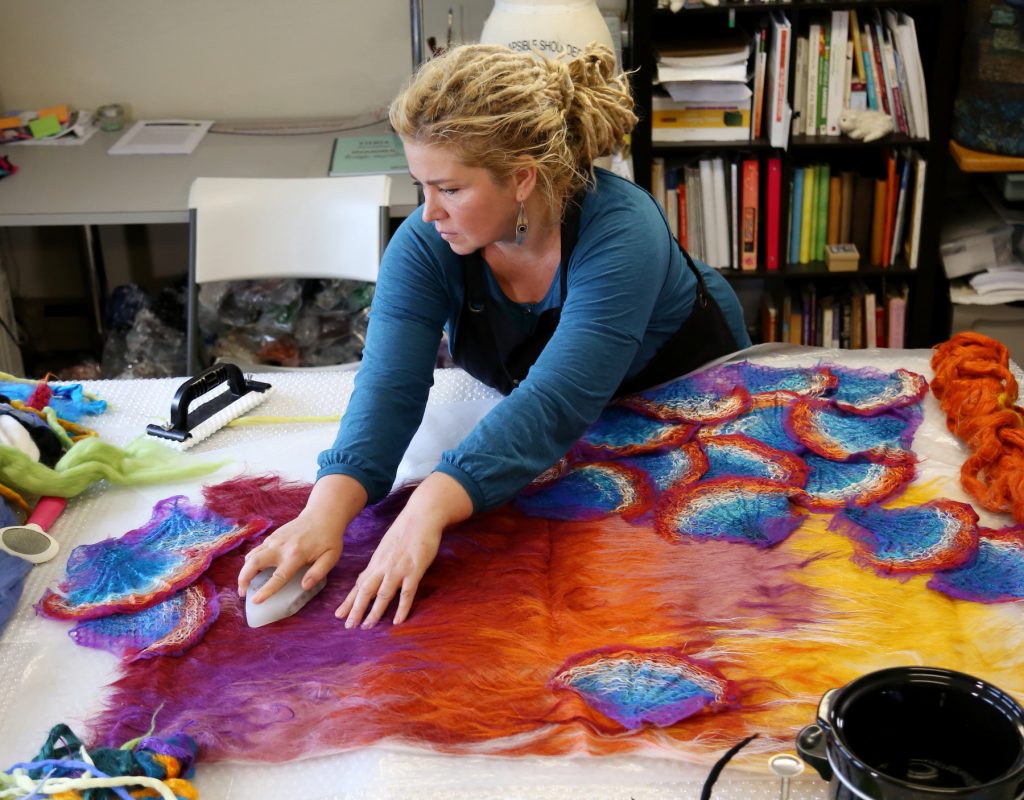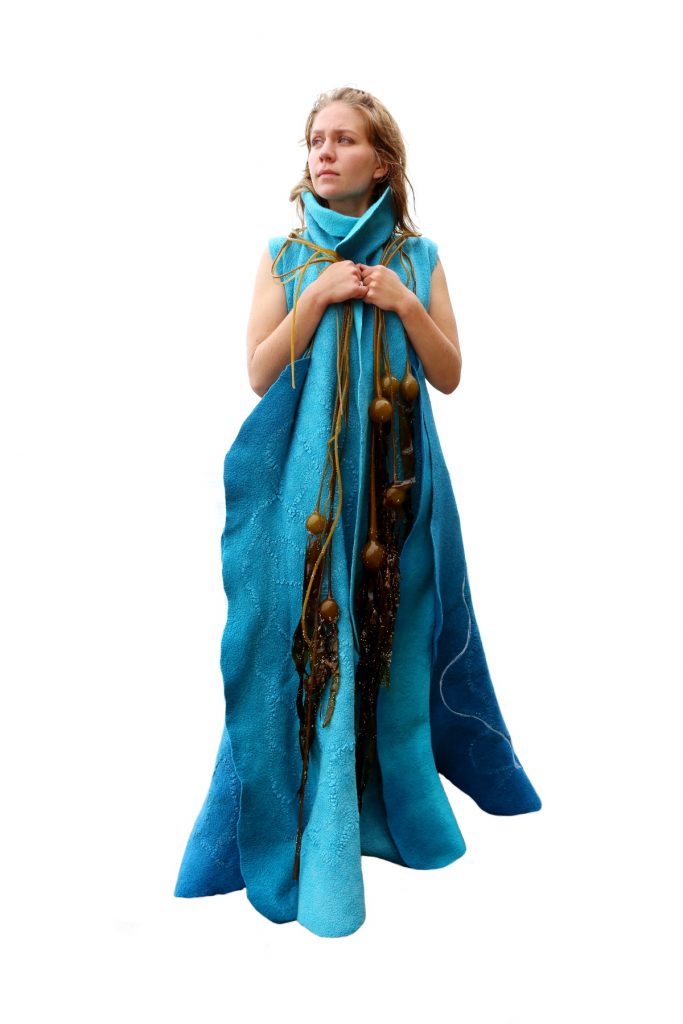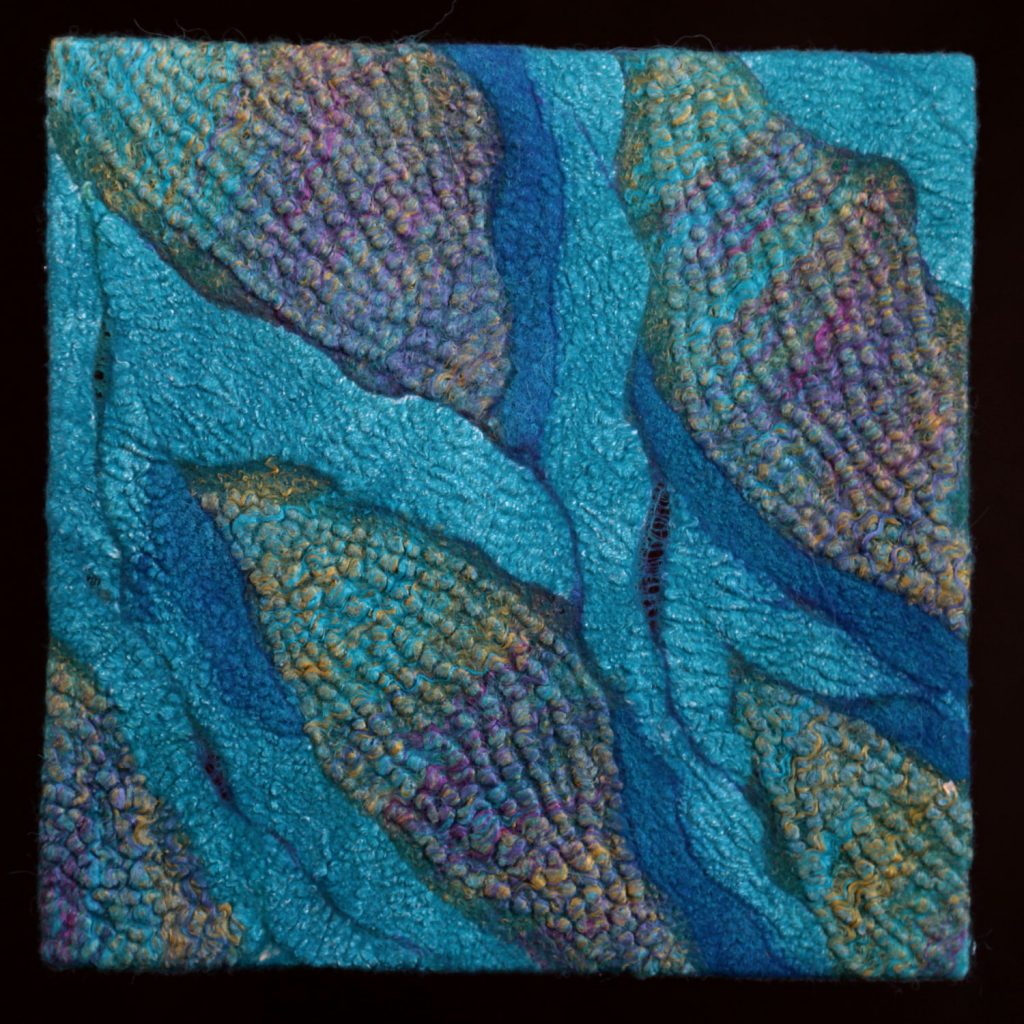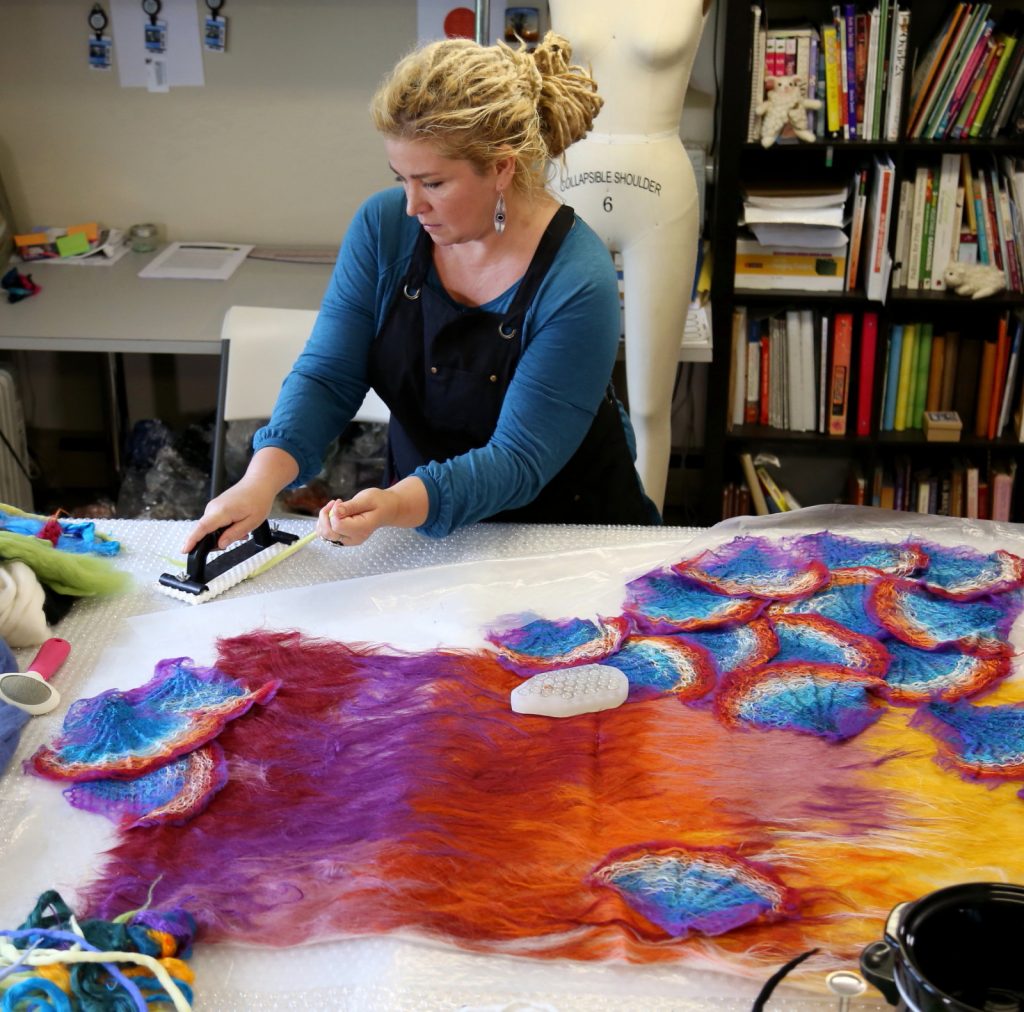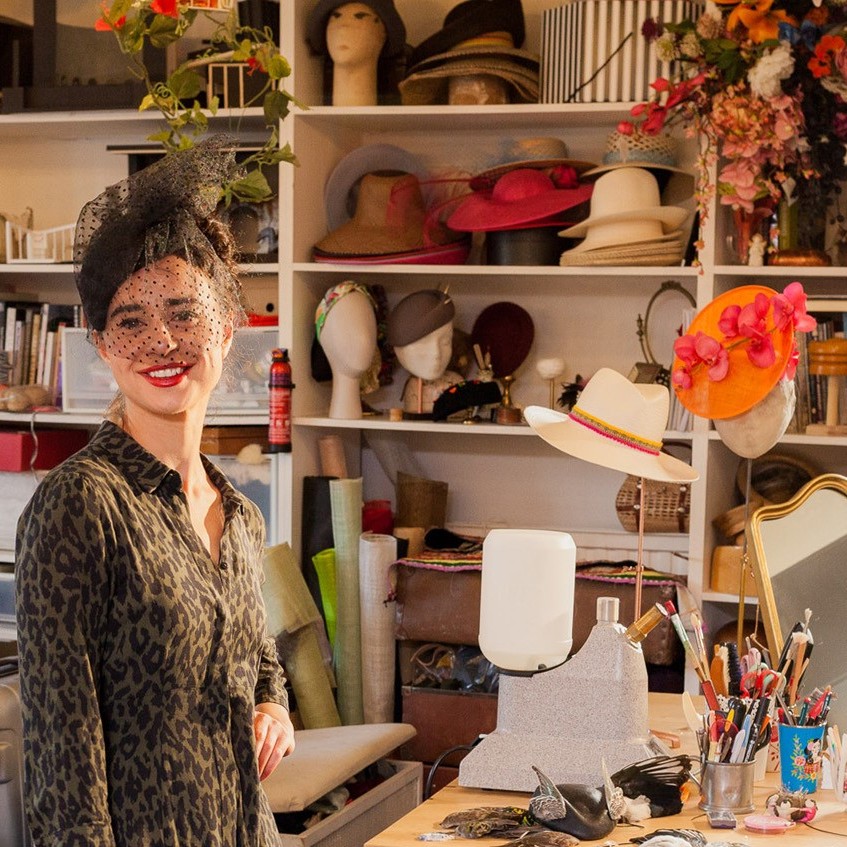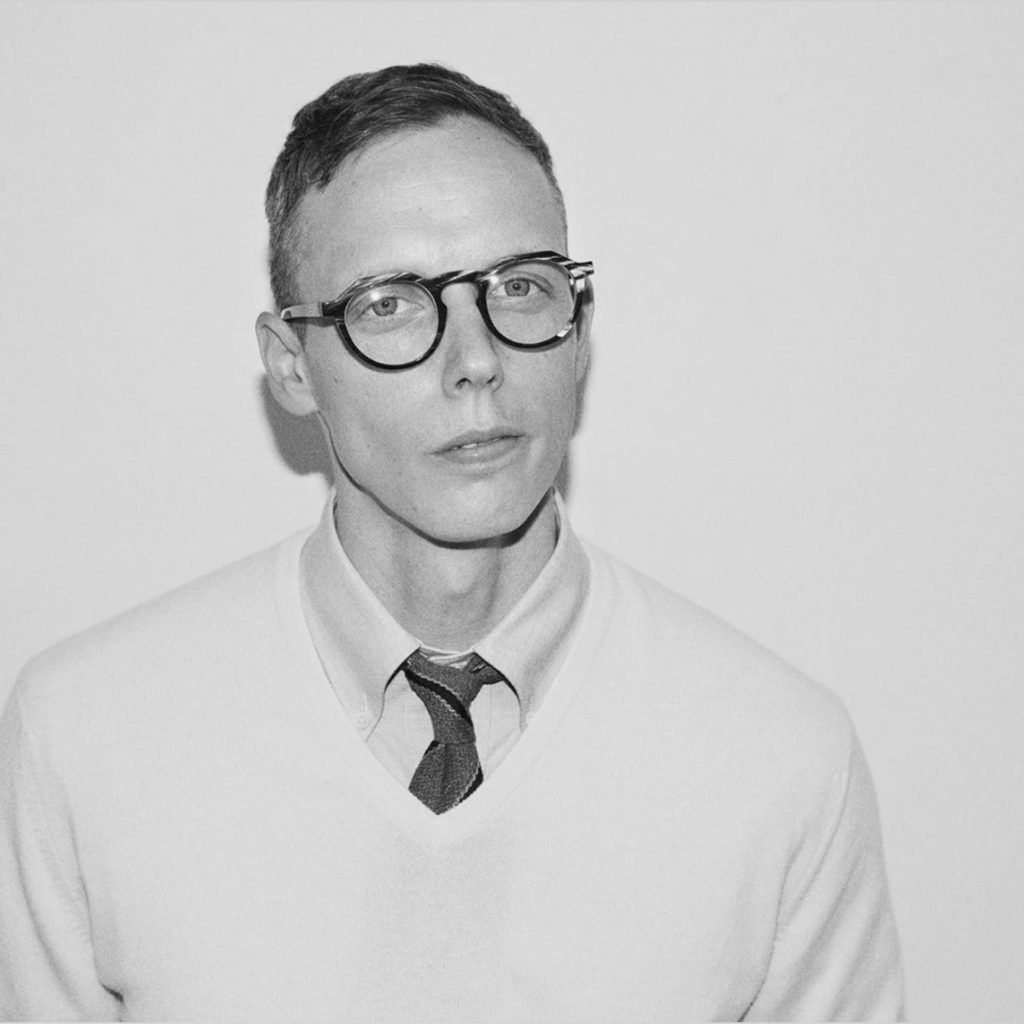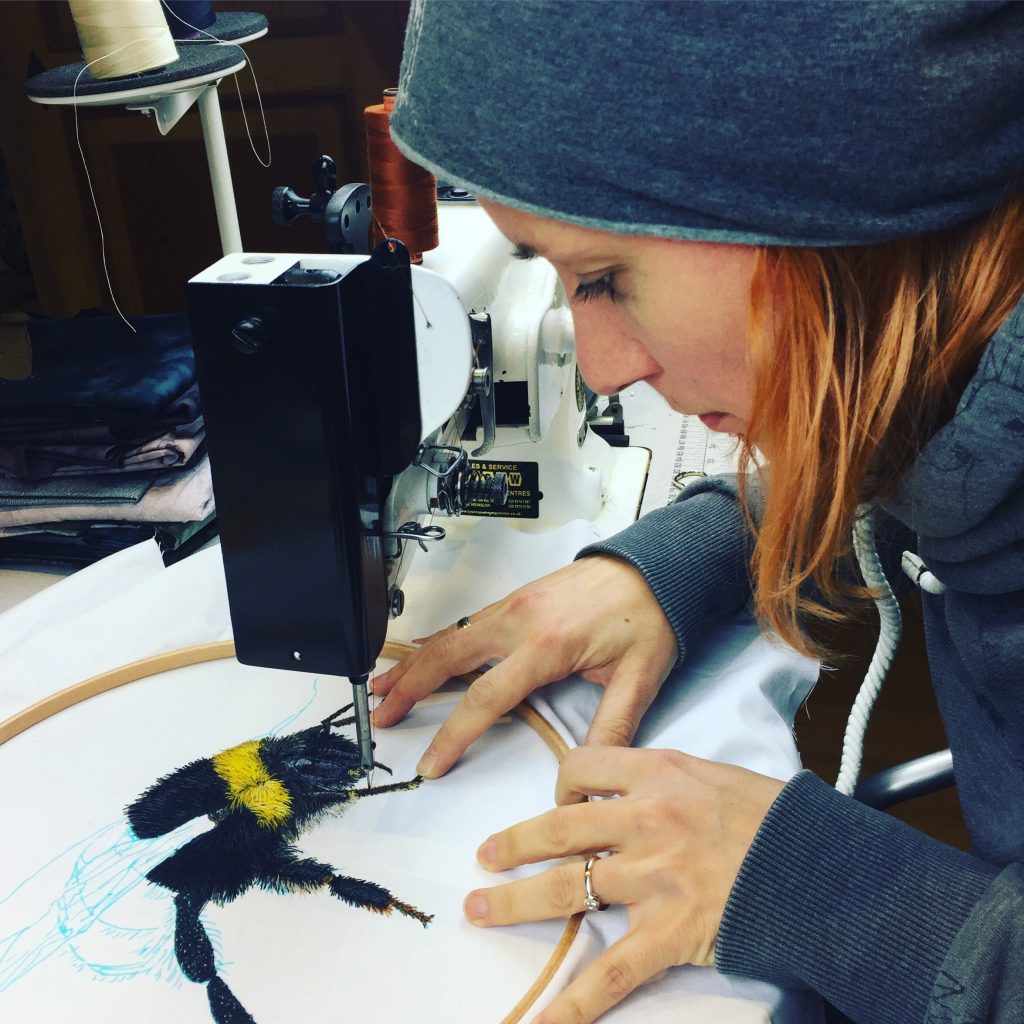Yekaterina (Katia) Mokeyeva Textile Artist
Take one piece that you are proud of and explain why?
Innovation is what I am probably the proudest of. In sayings like “The new is the well-forgotten old”, there is a sliver of truth. Revivals emerge constantly, in various areas of art. Aside from this, borrowing ideas from nature is natural to mankind, and similar “natural” ideas have occurred spontaneously in different places and time periods. A unique handling of such an idea is the technical interpretation and processing of it into something new, something that has never previously been applied in this craft. That would be innovation, and it enables development and progress of this craft as a whole.
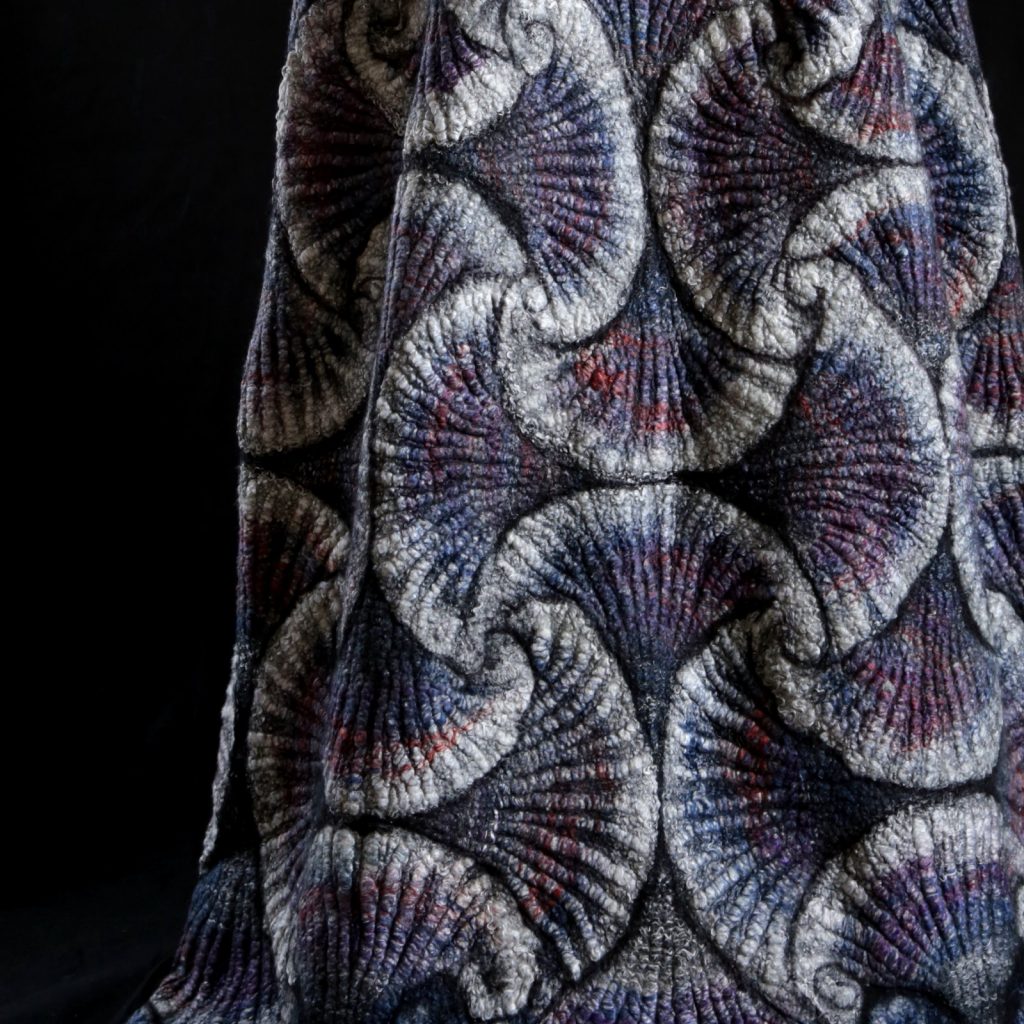
Mesmerizing Patterns, detail
My mosaic fiber structures, “Mesmerizing Patterns”, constructed from small pre-felted elements with the necessary application of plant fibers, happen to be a form of innovation.
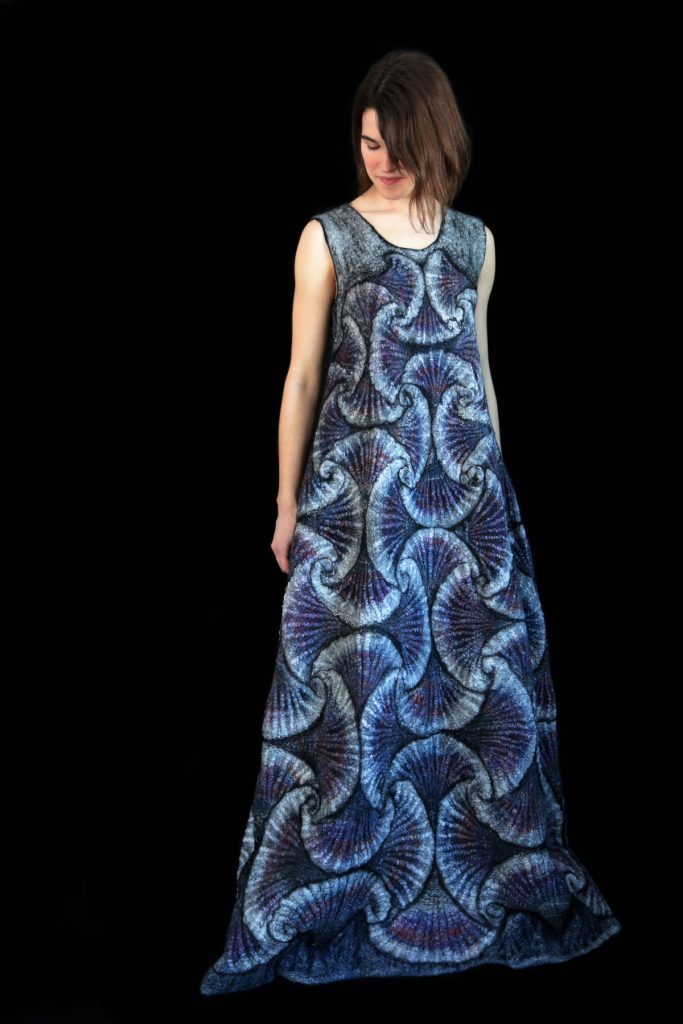
Mesmerizing Patterns
Take one of your full-length dresses and discuss…
Form
Wearable sculpture. Oblong, contour-flowing, repeating the curves of the human body, but not snug, somewhat free and swaying instead. It should be laconic and without excess, with clean and rounded edges, a form that does not detract content from perception, and is akin to an amphora.
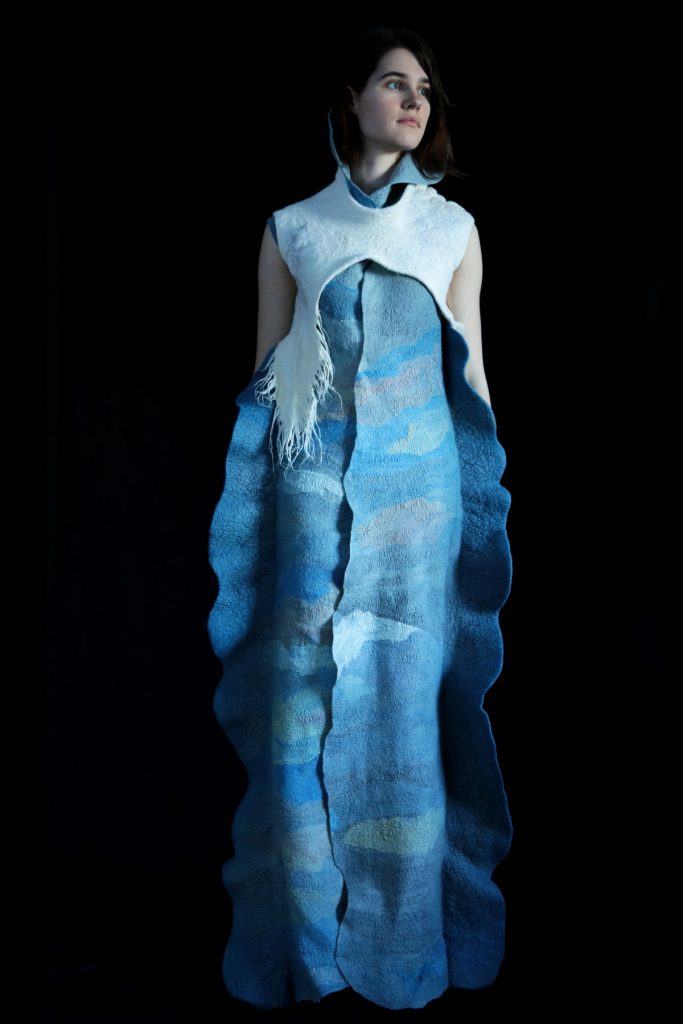 Conceptual
Conceptual
Technique
This is a 3-D hollow form that was practically sculpted and assembled from a multitude of hand-twisted felt ropes. There is no fabric involved, only wool and plant fiber comprising multiple small parts that are constructed together on a durable base layer, and a surface made of plant-derived fiber (Ramie roving).
Completed weight
Completed Weight. 990 grams (2 pounds 3 oz)This is a rather hefty piece. If it were an ordinary dress, that is. In this case, the weight is rather humble for a sculpture.
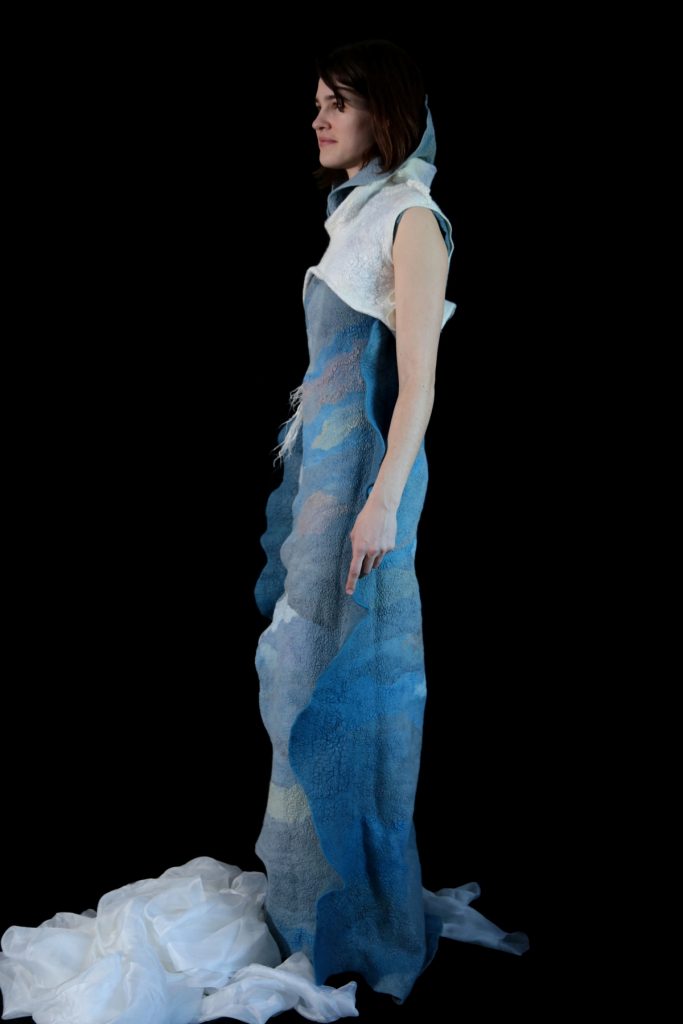
Conceptual
Colour and colour combinations
With the abundance of texture here, the variety of color had to remain minimal. Black was used to enhance contrast and depth, white for relief sculpting of voluminous textures, as well as creating light for prominent areas. Turquoise is often perceived as the color of water (if not the sky). It was my desire to use a bit of color to expand a theme – the theme of ocean elements.
Who the garment was made for or why it was made.
This exhibit piece is one of a group of wearable sculptures created for a project of a thematic duo-exhibition. I depicted the forms of an ocean in its various stormy conditions; some part of this depiction was metaphorical, and some of it bore a stylized resemblance to a lively, rampant sea.
Discuss the differences you noticed in your training between Moscow and San Francisco?
In Moscow, especially during the old times, art schools possessed an incredibly strong academic foundation. All art schools, regardless of the major, demanded a serious amount of classical training to be demonstrated at the exams. Many students, despite their display of outstanding skill and potential, had to apply several years in a row to even be considered, and were often rejected. A significant part of studying consisted of classical fundamentals, Drawing, painting, composition. In any of the majors, whether it was applied art, furniture design, fashion, textile, or architecture, these fundamentals were present. One thing that surprised me in San Francisco, was that many of the students were not very good at drawing, but more attention was given to the majors there. Everyone worked with great effort (likely due to the fact that studying there was incredibly expensive). The conditions and equipment were, of course, top-of-the-line. And during their studies at the college, students were able to participate in international and national competitions and contests or obtain an apprenticeship somewhere. The approach to education was also wiser, more grounded to real life. For example, textile artists and clothing designers would work on projects and collections that were tied to realistic product lines and industries. In short, this was the more practical and rational approach.
Take a scarf / collar and discuss the different techniques included within on piece.
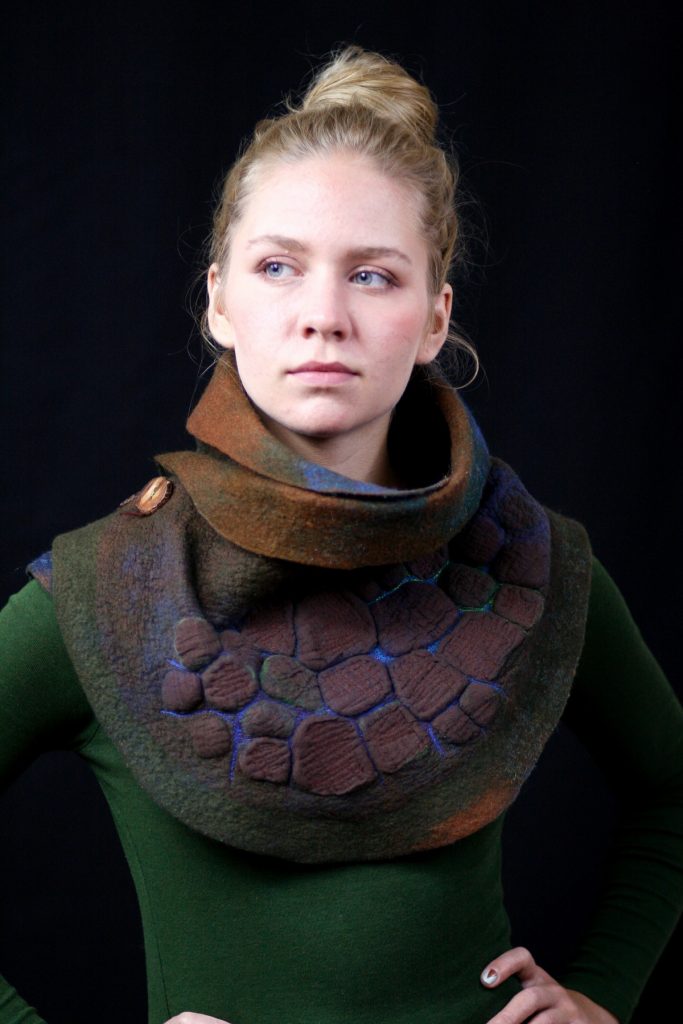
Turtle Shell
A statement piece that I created several years ago. it was already around then that I frequently used pre-felted elements, in this case, 3-dimensional segments of a “turtle shell”. It was necessary to consider the direction of the fibers in the layout (a layout which must first be spread out on a plane and is comprised of multiple little pieces of wool roving). The correct arrangement of the fibers helped to create a structure that accordingly takes on the correct form upon shrinkage. Of course, the piece is “sculpted” by hand, but the form is planned during the layout. The surface was laminated with loose-weave cotton gauze.
I worked with color, cold and warm tones, to procure liveliness of depth and dimension. Thin, vivid lines were made to create an effect of glowing, and I achieved it with machine stitching.
Expand on the use of colour in your work.
To me, color is an instrument of great importance. At some point, I studied color theory, but have little memory of the class, mainly because I continue to work with color relying on intuition, as I had when I was a child; in other words, I perceive color based on how the eye sees it and the soul desires it. The creation of a rich palette, or on the contrary, limiting colors, aids me in delivering the concept.
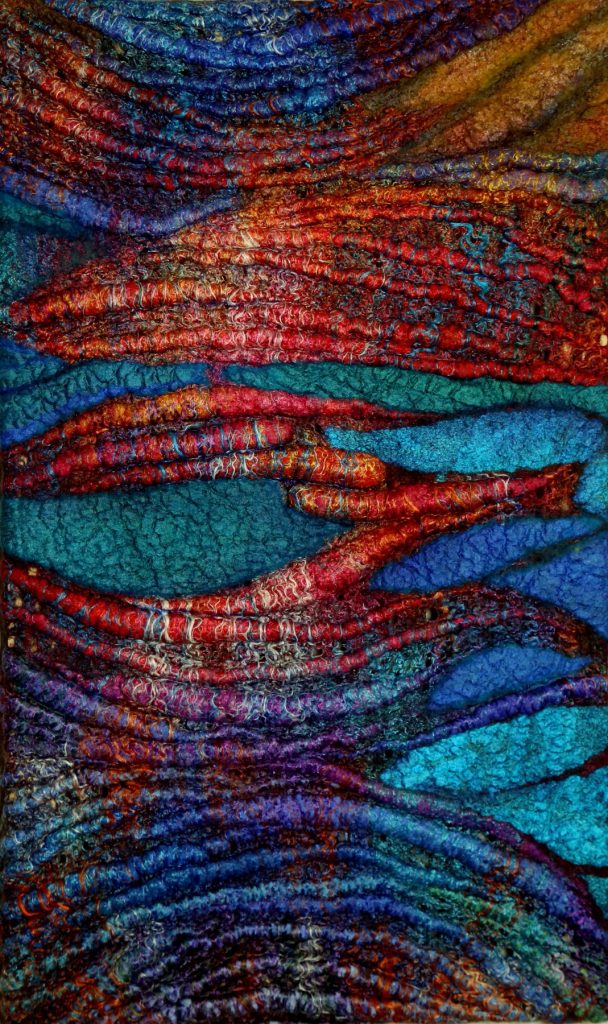
Colours 1
Wearable art as an art form
Sculptural, in this case fully “sculpted” from fibers, relative to the human body as another means of communicating a message but separate from mainstream fashion. With a mastery of craftsmanship and commitment to personal vision.

Sea
The reaction of the viewer and the reaction of the wearer.
The pieces that I create for exhibition projects are more likened to installations. The wearer puts them on for demonstration or photo session, but not as a regular garment. For a time, the wearer becomes a part of the project, a participant in a scene of an entire performance. The viewer, apart from being the recipient of the aesthetic, has an opportunity to make sense of the narrative, whether it is allegorical or metaphorical.
Wearable Art
How do you explain the importance of wearable art to the general public?
If someone asked me about the purpose of my pieces, I would reply with the simple answer that art comes in different forms. All art forms are equally important.

Sea of Nettles
How are you influenced by nature, to use natural fibres?
I direct my work down the stream that allows me to be closer to nature. Of course, attempts to return to the source and to be part of nature poses somewhat of a challenge for the modern human. But the ability to absorb inspiration from the natural surroundings rewards with a sense of euphoria. My last three years, I have spent living in the woods. Working with animal and plant fibers couldn’t be any closer to my universe in this setting. Fiber is a soft and natural medium; its flexibility and texture feel very much alive.
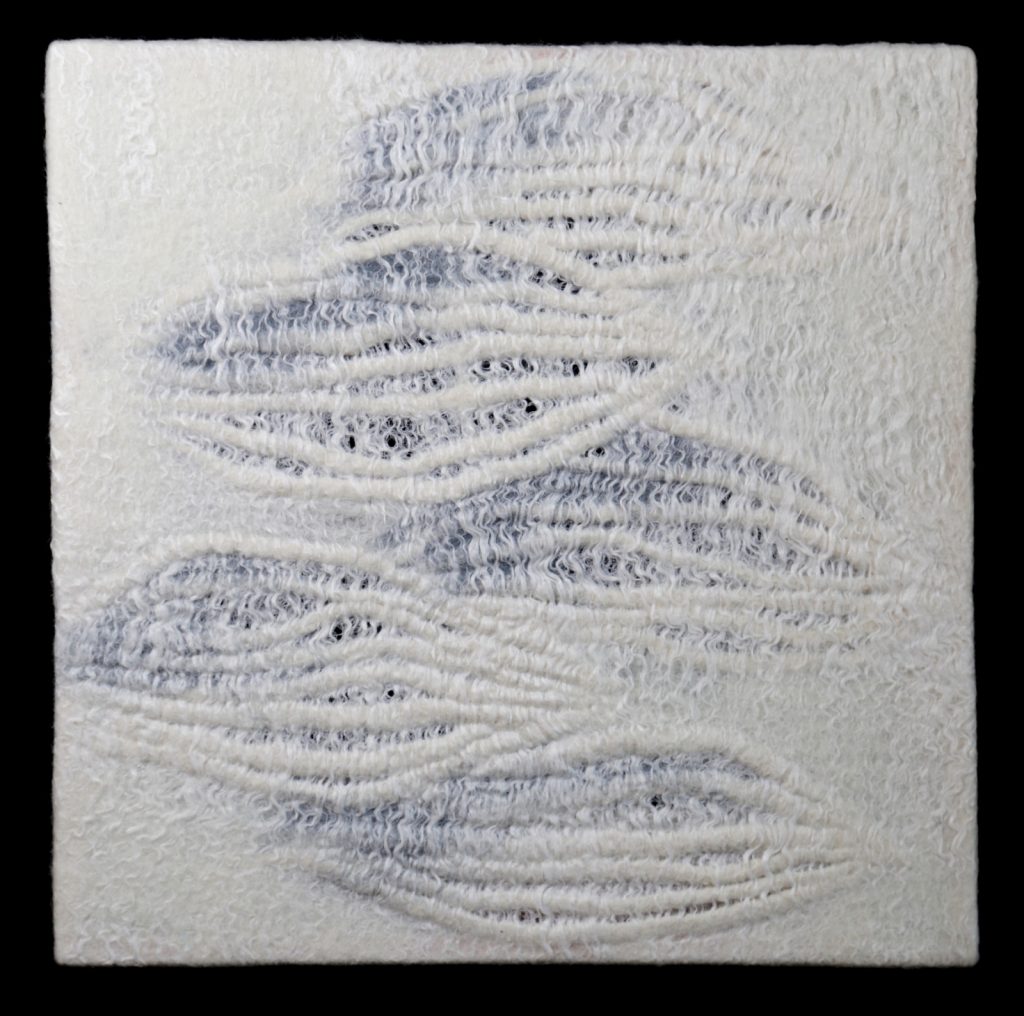
Color 21
How do you respond to natural fibres and how they combine to give the effect you are after?
Some of those fibers, unfortunately, are a result of processing that demands the utilization of various chemicals and dyes. While newer technologies have not yet replaced the ones currently in use, a compromise is made because the color and thinness of the fibers in some cases are essential. All of this is a similar process as in sculpture and painting. The key difference being that in place of using clay, or applying pigments, I apply and shape small pieces of animal and plant fiber. Fiber is quite responsive material. I create my surfaces using practically the tips of my fingers.
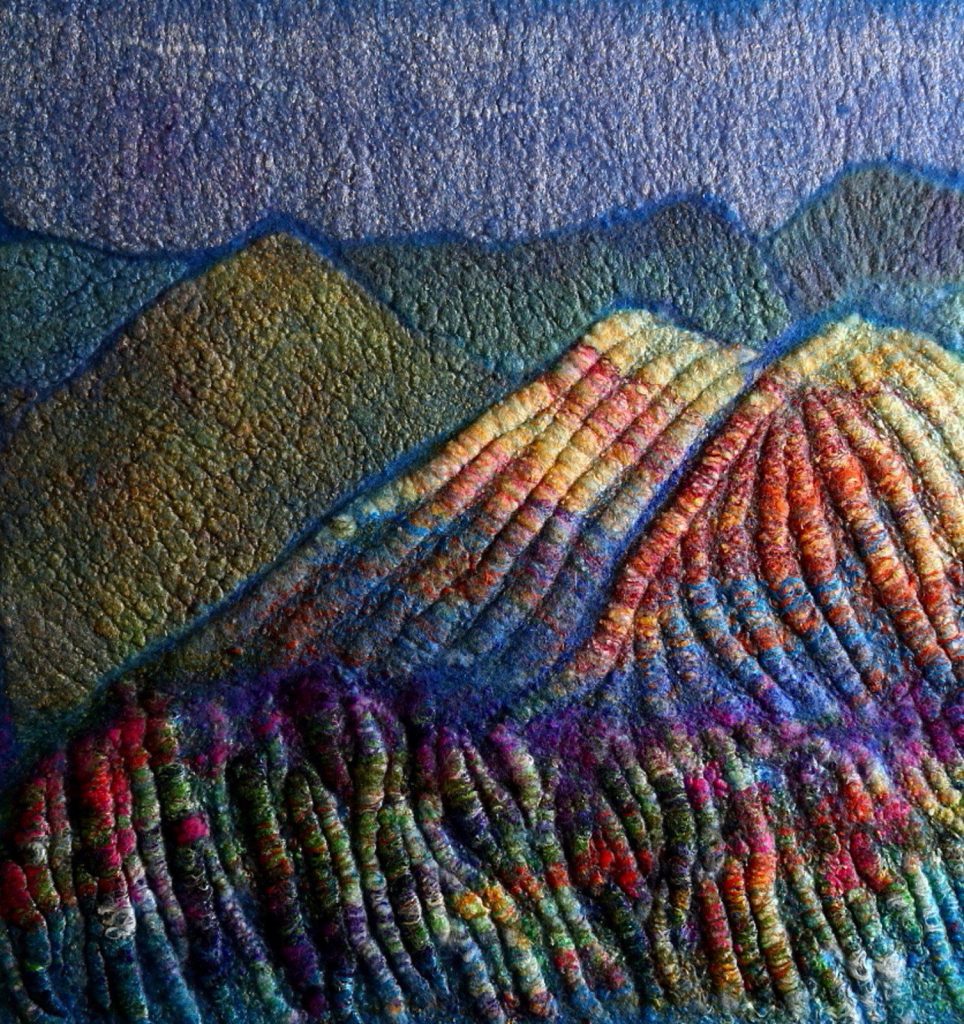
Color 3
How do you use your sketch book to develop a piece?
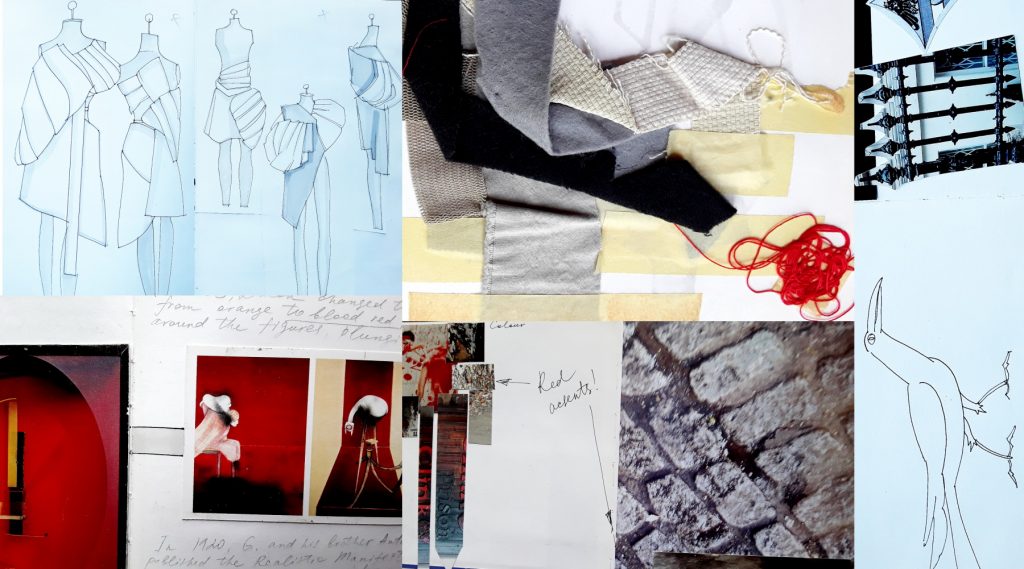
I doodle. Doodling has been a habit of mine for as long as I can remember. Because of this, I would sometimes get into trouble as a child. Of course, it isn’t always possible to carry a sketchbook with you everywhere you go, and a calm moment is considered a luxury in our day and age. And yet, a few mindless doodles can procure the formation of bigger ideas.
- If making small sketches was already a natural habit, then I learned it in London when I took the summer study abroad program at Central St. Martins. Taking photographs of any interesting subject, whether it was nature, an object, or a color combination, or surface, then printing out those images on a simple color printer, was another way.
Then, to manipulate them, cut, take apart, put together, turn upside down, blow up or reduce in size, and so on.
- Short notes. They don’t need to be full sentences, sometimes just unrelated words, or emotional states or impressions of something.
It isn’t necessary to collect those impressions or words for one project only. Sometimes, the final image of whatever I intend to create hasn’t fully developed itself in my mind (it happens). I could flip through my sketchbook, or even through one of my old sketchbooks; this awakes a process, thanks to which an abstract idea could become defined and concrete. There are also other techniques used in working with sketchbook materials, and they help to form outside-of-the-box-ideas. These methods I share with the participants of my art retreats.
Discuss retreats in relation to both the development for students and you as a teacher? The value of being in a special place.
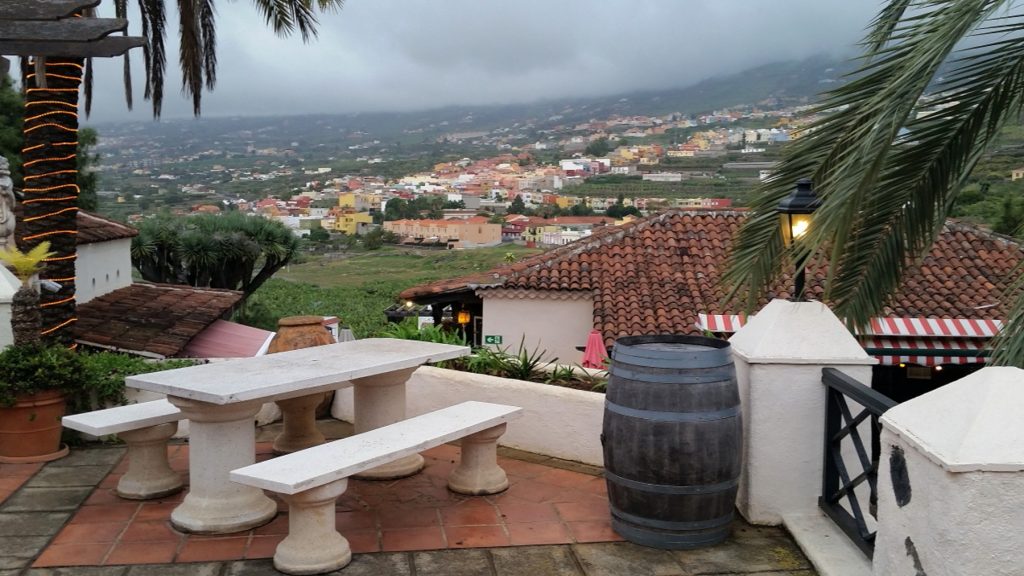
Tenerife Retreat
Celebration, a special unforgettable time, an event for which a desirable place is chosen. How often do we celebrate our creative identity and our love for our craft? Of course, even working in solitude in your studio can bring great joy. But my retreats are a true manifestation of all that is most wonderful.
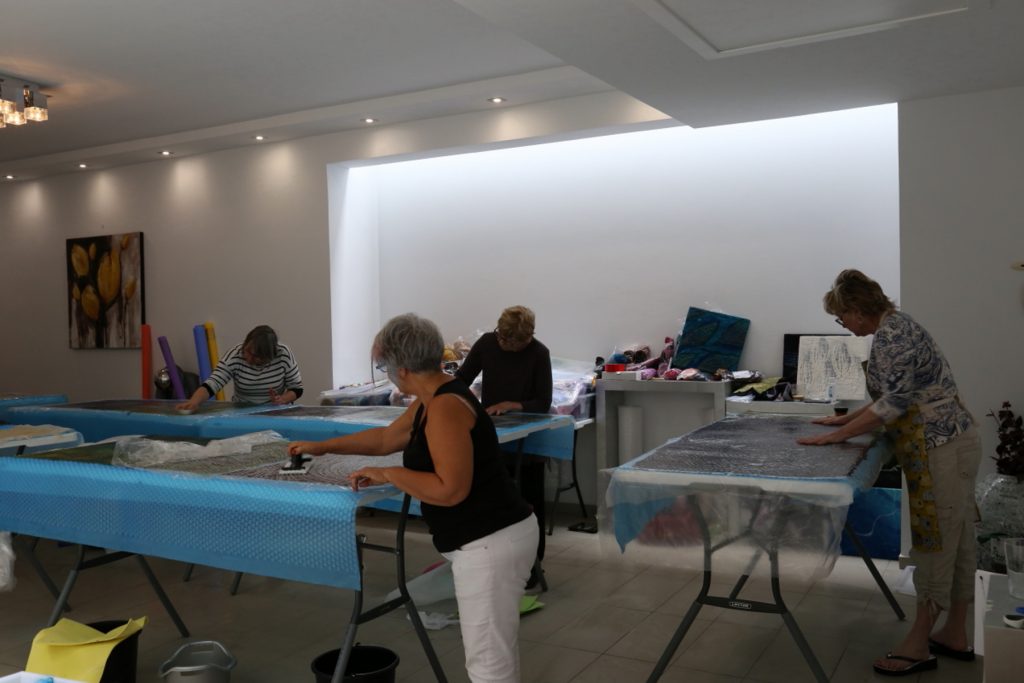
Tenerife Retreat
Breaking out of the daily routine, discovering beautiful surroundings, working with the best quality materials, is a great way to charge your inspiration for years to come. It is a nurturing event for my participants and myself as a teacher and organizer. Once upon a time, the vivid impression my time spent in studying abroad endowed my London sketchbook with magical powers.
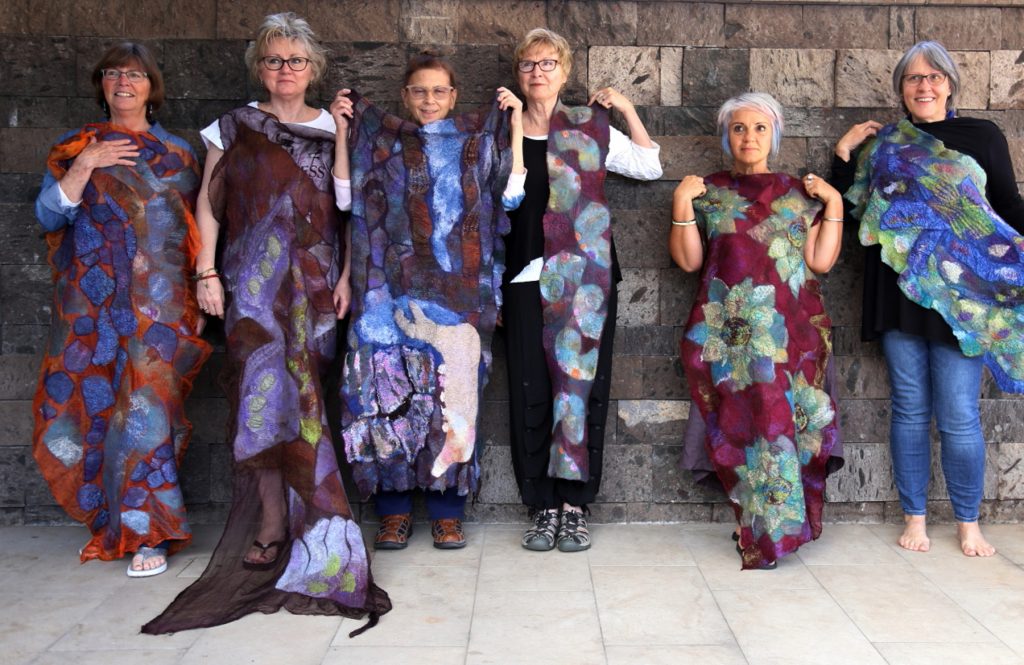
Tenerife Retreat
You teach on-line classes; can you share what is involved?
First and foremost, a great deal of patience is required. This is a challenge for my naturally restless character. Online classes demand a tremendous amount of computer work.
How do you set up a class?
Each lesson must first be drafted prior to being photographed and filmed, the videos processed and edited, and among all of that, detailed instruction must be given as everything is documented. Whenever I compose a course, it is as though I do a recount of all the years of my work, throughout which I developed and mastered the techniques that I share with my students. Such labor is both satisfying and bears great responsibility. It also forces you to be brave and open with the world. It is as though you invite people directly into your studio, most of them are strangers whose faces you’ve never seen. At the same time, some of them become friends. A soft and warm medium unites people and brings them joy!
What materials list do you suggest to students?
The materials we used were quite beautiful and attractive – premium quality wool roving, all sorts of plant fibers, luxurious silks, an abundance of colors.
Color 11
How available are the materials (worldwide)?
I have accumulated a pretty extensive list of suppliers from different corners of the world. This includes tens of websites, each of them readily supplying ordered goods through the internet. I share this list with my class participants, and they add to it as well with their own sources.
How far and wide are the students who you teach?
If someone had told me, a person born in Ukraine and raised in Soviet Moscow some 25 years ago, that the extent of such communication is possible, I would never have believed it then. But it is a fact – my students live on every populated continent. I teach fellow Americans from every state, including Hawaii and Alaska, Canadians from far up North, people on all ends of Australia, South Africa, South America (Chile, Argentina, Mexico), practically all Western European countries, Scandinavia, Eastern Europe, the UK, Russia, Cyprus, China, as well as Japan (and the locations grow). Such are the incredible times we live in.
How do you incorporate this with your existing art practice?
All courses last between 4 and 9 weeks, with 1-2 lessons per week. The course materials are distributed on a specific platform and are made available to students at any time for them to access. Nonetheless, my participation is also necessary, as I give advice, explain to students the more complex nuances, and then review their results in a virtual classroom. This could take at least several hours, if not many more in the span of one day, and throughout the entire course. No other major projects or trips are possible during this time. Therefore, there are weeks dedicated to the classes, so that I may include some studio work, but nothing beyond that. Tutoring is a time-consuming process that requires dedication.
Studio shot
What have been three important lessons you have learnt and how do you now rely on them in your art?
Trust yourself. The truth, which did not reveal itself to me immediately, is that wherever there is a desire to please someone and meet their expectations, or to land into a fashionable trend, true art begins to hit a bit of a dead end and is instead replaced by conjuncture. Everything that is best is born from the depths of the heart and intuition.
An appetite emerges during a meal (as my grandma would say), and inspiration – during work. The endless wait for ever-elusive inspirational motivation is procrastination. As soon as you begin your work, your muse may arrive, sometimes with a completely unexpected idea.
Making a living being an artist quite a bit of anxiety. And anxiety is a creativity killer. I am learning to live here and now, in the present moment. It helps me to carry on, and it is not a finalized lesson.
Expand on your piece, “Darkness Is Your Candle”
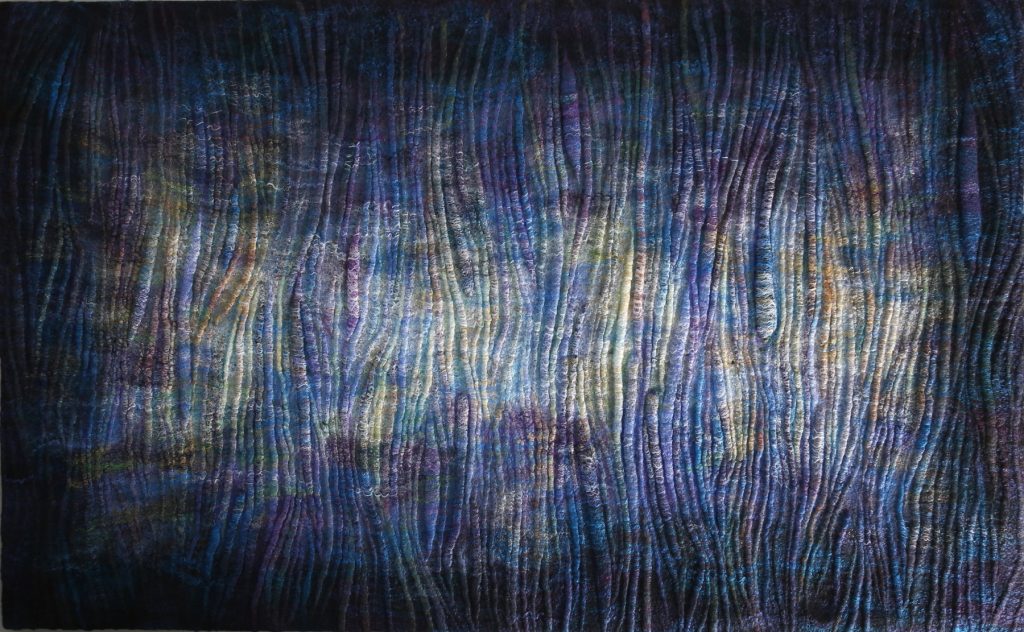
Darkness Is Your Candle, 142 cm X 89 cm, cellulose fiber wet felted on wool fiber base.
What lead you to move to do a large 2D piece?
The size was not very challenging or something new. Some of my 3-D wearable sculpture pieces have larger dimensions than this work.
The surface consists of well-defined pre-sculpted small 3-D elements. An intense use of tone, color and texture in one work was enough to deliver the idea. Therefore a choice was made to favor the 2-D format.
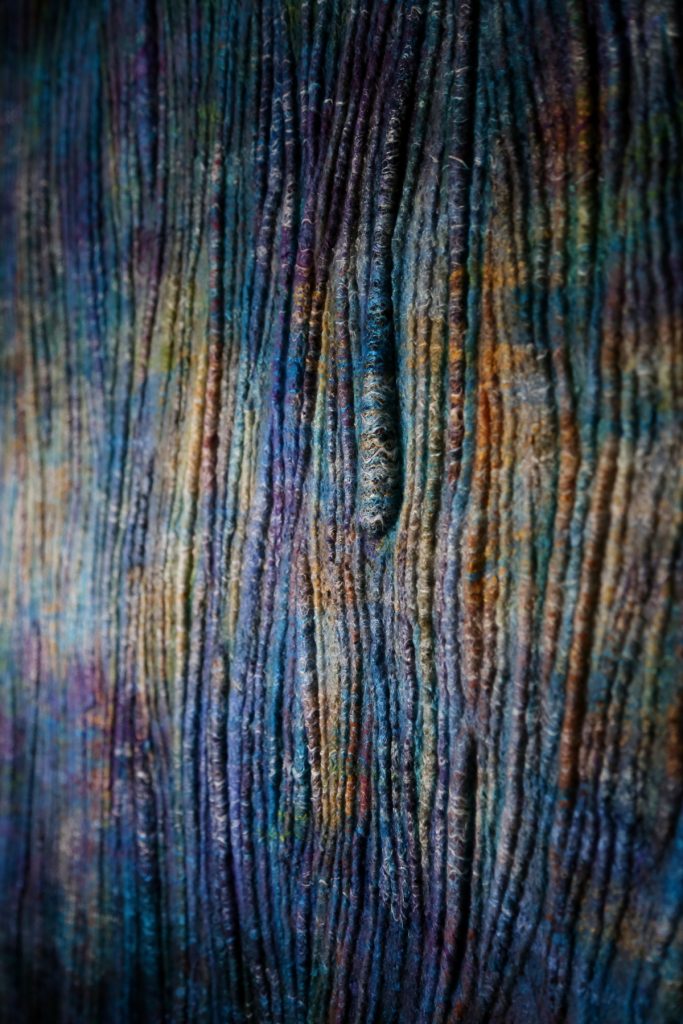
Darkness Is Your Candle, detail
Discuss the use of colour and lustre
A combination of warm and cool shades and a large tonal range, from almost black to “shining” light hues were the means by which I was able to achieve the effect of glowing. No lustrous or glittery fibers were used here, and no special lighting is required. The “glow” was merely painted using cellulose fibers of various colors.
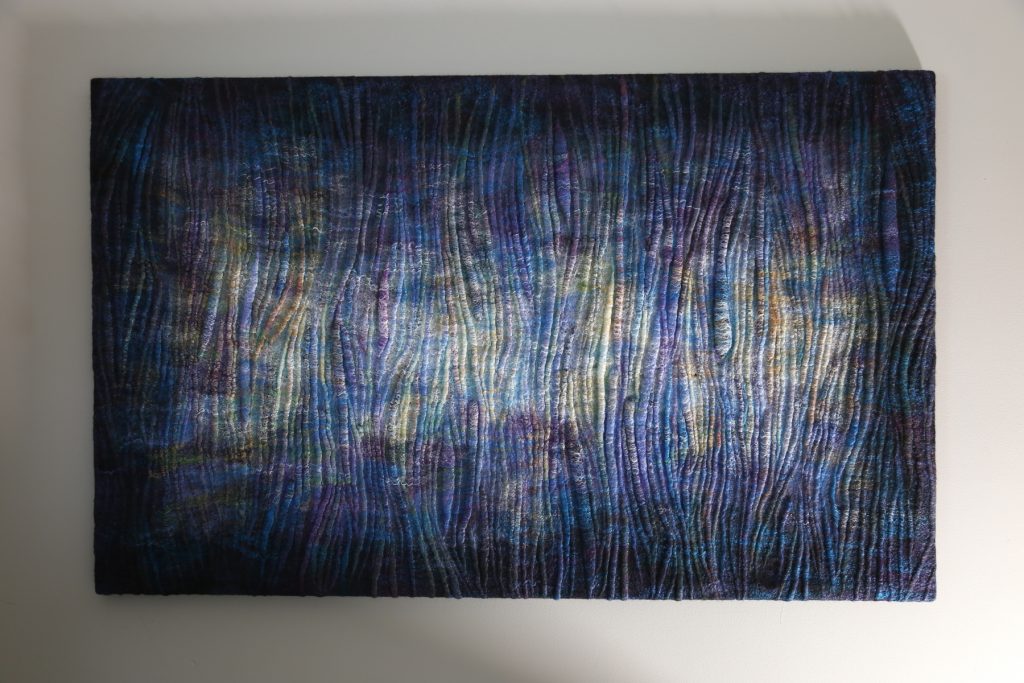
Darkness Is Your Candle
Where did the inspiration come from?
Since the beginning of my relationship with this medium, I tried applying the techniques that I used in my old paint and pastel works. The ways of depicting light, or an even more interesting idea of creating a ‘glow from the inside’, was something that always fascinated me. Several years ago I made a series of conceptual garment pieces called “Bioluminescence.”
“Darkness is your candle,” this is the line from “Wetness and Water” by Rumi, the 13th century Persian poet. The emotional state, as well as memories of life experiences encompassed in a whole, resonated with the meaning of those words, and have become a foundation of this piece.
“No matter how fast you run,
your shadow more than keeps up.
Sometimes it’s in front.
Only full, overhead sun
diminishes your shadow.
But that shadow has been serving you.
What hurts you blesses you.
Darkness is your candle.
Your boundaries are your quest.” ― Rumi, The Big Red Book
Contact:
Yekaterina (Katia) Mokeyeva
https://www.feuer-und-wasser.com
https://www.facebook.com/FeuerUndWasser
Deborah Blakeley, Melbourne, Australia
Interview by Deborah Blakeley, September 2019
Think a colleague or friend could benefit from this interview?
Knowledge is one of the biggest assets in any business. So why not forward this on to your friends and colleagues so they too can start taking advantage of the insightful information the artist has given?
Other artists you may be interested in:


